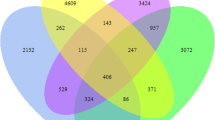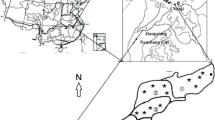Abstract
Wastewater (WW) irrigation to agricultural soils is one of the most economical and effective water-saving strategies. The effects of WW irrigation on soil microbial communities have gained increasing focus as these effects are not well understood. In this study, the effects of WW and groundwater (GW) irrigation on microbial diversity and structure were compared using the high-throughput sequencing analysis of 16S rDNA amplicons. Soil samples irrigated by WW for several decades and maize soil (loamy) samples irrigated by GW were collected from Luancheng Town, Shijiazhuang City, China. Compared to the GW groups, WW groups exhibited non-significant soil bacterial community abundance at the 0–20 and 20–40 cm depths. WW irrigation significantly altered the bacterial community composition and structures compared to GW irrigation. The relative abundance of Proteobacteria and Firmicutes increased in WW irrigated soil, while Actinobacteria decreased. Moreover, 14 significantly abundant biomarkers from Proteobacteria and Firmicutes that corresponded with WW irrigation were identified. Additionally, WW irrigation enriched some KEGG pathways that corresponded with metabolism and human diseases. The physical and chemical properties of WW irrigated soil may shape the compositions and structures of soil bacterial communities. The findings of this study illuminated the effects of wastewater irrigation on microbial characteristics, which is important for estimating the effects of long-term wastewater irrigation on soil environmental health.






Similar content being viewed by others
Data Availability
The datasets generated during and/or analyzed during the current study are available from the corresponding author on reasonable request.
References
Valipour M, Singh VP (2016) Global experiences on wastewater irrigation: challenges and prospects. In: Maheshwari B, Singh V, Thoradeniya B (eds) Balanced urban development: options and strategies for liveable cities. Springer, Cham, pp 289–328
Zhang YC, Shen YJ (2019) Wastewater irrigation: past, present, and future. WIREs Water 6(3):e1234
Murtaza G, Ghafoor A, Qadir M, Owens G, Aziz MA, Zia MH, Saifullah R (2010) Disposal and use of sewage on agricultural lands in Pakistan: a review. Pedosphere 20(1):23–34
Jiménez B, Drechsel P, Koné D, Bahri A, Raschid-Sally L, Qadir M (2010) Wastewater, sludge and excreta use in developing countries: an overview. In: Bahri A, Drechsel P, Raschid-Sally L, Redwood M, Bahri A (eds) Wastewater irrigation and health: assessing and mitigating risk in low-income countries. London, Earthscan, Ottawa, International Development Research Centre (IDRC); Colombo, International Water Management Institute (IWMI), pp 3–27
Akoto-Danso EY, Manka’abusi D, Steiner C, Werner S, Häring V, Nyarko G, Marschner B, Drechsel P, Buerkert A (2019) Agronomic effects of biochar and wastewater irrigation in urban crop production of Tamale, northern Ghana. Nutr Cycl Agroecosyst 115:231–249
Häring V, Manka’abusi D, Akoto-Danso EK, Werner S, Atiah K, Steiner C, Lompo DJP, Adiku S, Buerkert A, Marschner B (2017) Effects of biochar, waste water irrigation and fertilization on soil properties in West African urban agriculture. Sci Rep. 7:10738
Jackson RB, Lajtha K, Crow SE, Hugelius G, Kramer MG, Piñeiro G (2017) The Ecology of Soil Carbon: Pools, Vulnerabilities, and Biotic and Abiotic Controls. Annu Rev Ecol Evol Syst 48:419–445
Frenk S, Hadar Y, Minz D (2013) Resilience of soil bacterial community to irrigation with water of different qualities under Mediterranean climate. Environ Microbiol 16(2):559–569
García-Orenesa F, Caravacab F, Morugán-Coronadoa A, Roldán A (2015) Prolonged irrigation with municipal wastewater promotes a persistent and active soil microbial community in a semiarid agroecosystem. Agr Water Manage 149:115–122
Guo W, Andersen MN, Qi XB, Li P, Li ZY, Fan XY, Zhou Y (2015) Effects of reclaimed water irrigation and nitrogen fertilization on the chemical properties and microbial community of soil. J Integr Agr 16(3):679–690
Lu F, Yang J, Li H (2014) Risk evaluation of heavy metals in soil in the sewage irrigation area A case study of shijiazhuang. J Chem Pharm Res 6(6):2147–2152
Guo X, Zhao T, Liu L, Xiao C, He Y (2018) Effect of Sewage Irrigation on the CT-Measured Soil Pore Characteristics of a Clay Farmland in Northern China. Int J Env Res Public Health 15(5):1043
Lu RK (2000) Chemical analysis methods of agricultural soil. China Agricultural Science and Technology Press, Beijing
Bao SD (2000) Soil agro-chemical analysis. China Agricultural Science and Technology Press, Beijing
Bolyen E, Rideout JR, Dillon MR, Bokulich NA, Abnet C, AI-Ghalith GA, Alexander H, Alm EJ, Arumugam M, Asnicar F, Bai Y, Bisanz JE, Bittinger K, Brejnrod A, Brislawn CJ, Brown CT, Callahan BJ (2018) QIIME 2: Reproducible, interactive, scalable, and extensible microbiome data science. PeerJ Preprints. https://doi.org/10.7287/peerj.preprints.27295v1
Quast C, Pruesse E, Yilmaz P, Gerken J, Schweer T, Yarza P, Peplies J, Gloeckner FO (2013) The SILVA ribosomal RNA gene database project: improved data processing and web-based tools. Nucleic Acids Res 41:D590–D596
Zaura E, Keijser BJF, Huse SM, Crielaard W (2009) Defining the healthy "core microbiome" of oral microbial communities. BMC Microbiol 9:259
White JR, Nagarajan N, Pop M (2009) Statistical methods for detecting differentially abundant features in clinical metagenomic samples. PLoS Comp Biol 5(4):e1000352
Simpson EH (1949) Measurement of Diversity. Nature 163:688
Pielou EC (1966) The measurement of diversity in different types of biological collections. J Theor Biol 13:131–144
Clarke KR (1993) Non-parametric multivariate analyses of changes in community structure. Aust J Ecol 18:117–143
Warton DI, Wright ST, Wang Y (2012) Distance-based multivariate analyses confound location and dispersion effects. Methods Ecol Evol 3:89–101
Segata N, Izard J, Waldron L, Gevers D, Miropolsky L, Garrett WS, Huttenhower C (2011) Metagenomic biomarker discovery and explanation. Genome Biol 12:R60
Douglas GM, Beiko RG, Langille MGI (2018) Predicting the functional potential of the microbiome from marker genes using PICRUSt. Methods Mol Biol 1849:169–177
Kanehisa M, Goto S, Kawashima S, Okuno Y, Hattori M (2004) The KEGG resource for deciphering the genome. Nucleic Acids Res 32:D277–D280
Lauber C, Ramirez K, Aanderud Z, Lennon J, Fierer N (2013) Temporal variability in soil microbial communities across land-use types. ISME J 7:1641–1650
Haichar F, Marol C, Berge O, Rangel-Castro JI, Prosser JI, Balesdent J, Heulin T, Achouak W (2008) Plant host habitat and root exudates shape soil bacterial community structure. ISME J 2:1221–1230
Hemkemeyer M, Christensen BT, Martens R, Tebbe CC (2015) Soil particle size fractions harbour distinct microbial communities and differ in potential for microbial mineralization of organic pollutants. Soil Biol Biochem 90:255–265
Meier C, Wehrli B, van der Meer JR (2008) Seasonal fluctuations of bacterial community diversity in agricultural soil and experimental validation by laboratory disturbance experiments. Microb Ecol 56:210–222
Krause SMB, Dohrmann AB, Gillor O, Christensen BT, Merbach I, Tebbe CC (2020) Soil properties and habitats determine the response of bacterial communities to agricultural wastewater irrigation. Pedosphere 30(1):146–158
Zolti A, Green SJ, Mordechay EB, Had Y, Minz D (2019) Root microbiome response to treated wastewater irrigation, science of the total environment. Sci Total Environ 655:899–907
Chen L, Feng Q, Li C, Wei Y, Zhao Y, Feng Y, Zheng H, Li F, Li H (2017) Impacts of aquaculture wastewater irrigation on soil microbial functional diversity and community structure in arid regions. Sci Rep 7:11193
Dang Q, Tan W, Zhao X, Li D, Li Y, Yang T, Li R, Zu G, Xi B (2019) Linking the response of soil microbial community structure in soils to long-term wastewater irrigation and soil depth. Sci Total Environ 688:26–36
Ibekwe AM, Gonzalez-Rubio A, Suarez DL (2018) Impact of treated wastewater for irrigation on soil microbial communities. Sci Total Environ 622–623:1603–1610
Li B, Cao Y, Guan X, Li Y, Hao Z, Hu W, Chen L (2019) Microbial assessments of soil with a 40-year history of reclaimed wastewater irrigation. Sci Total Environ 651:696–705
Wafula D, White JR, Canion A, Jagoe C, Pathak A, Chauhan A (2015) Impacts of longterm irrigation of domestic treated wastewater on soil biogeochemistry and bacterial community structure. Appl Environ Microbiol 81:7143–7158
Bougnom BP, Thiele-Bruhn S, Ricci V, Zongo C, Piddock LJV (2020) Raw wastewater irrigation for urban agriculture in three African cities increases the abundance of transferable antibiotic resistance genes in soil, including those encoding extended spectrum β-lactamases (ESBLs). Sci Total Environ 698:134201
Broszat M, Nacke H, Blasi R, Siebe C, Huebner J, Daniel R, Grohmann E (2014) Wastewater irrigation increases the abundance of potentially harmful gammaproteobacteria in soils in Mezquital valley. Mexico Appl Environ Microbiol 80(17):5282–5291
Shen T, Liu L, Li Y, Wang Q, Dai J, Wang R (2019) Long-term effects of untreated wastewater on soil bacterial communities. Sci Total Environ 646:940–950
Xie S, Yang F, Feng H, Wei C, Wu F (2019) Assessment of potential heavy metal contamination in the peri-urban agricultural soils of 31 provincial capital cities in China. Environ Manage 64:366–380
Acknowledgements
This study was financially supported by the National Natural Science Foundation of China (Grant No. 41502241, 31870354) and the Henan Postdoctoral Foundation (Grant No. 001702041). The authors thank LetPub (www.letpub.com) for its linguistic assistance during the preparation of this manuscript.
Author information
Authors and Affiliations
Contributions
XX and SL carried out the field sampling, data analysis, and the writing of original manuscript. XZ took part in data analysis and the writing of the result part. XG designed this work, and reviewed and editing the manuscript.
Corresponding author
Ethics declarations
Conflict of interest
The authors declare that they have no conflict of interest.
Ethical Approval
This manuscript is an original work and never has been published elsewhere in any form or language.
Additional information
Publisher's Note
Springer Nature remains neutral with regard to jurisdictional claims in published maps and institutional affiliations.
Rights and permissions
About this article
Cite this article
Xu, X., Liu, S., Zhu, X. et al. Comparative Study on Soil Microbial Diversity and Structure Under Wastewater and Groundwater Irrigation Conditions. Curr Microbiol 77, 3909–3918 (2020). https://doi.org/10.1007/s00284-020-02219-5
Received:
Accepted:
Published:
Issue Date:
DOI: https://doi.org/10.1007/s00284-020-02219-5




